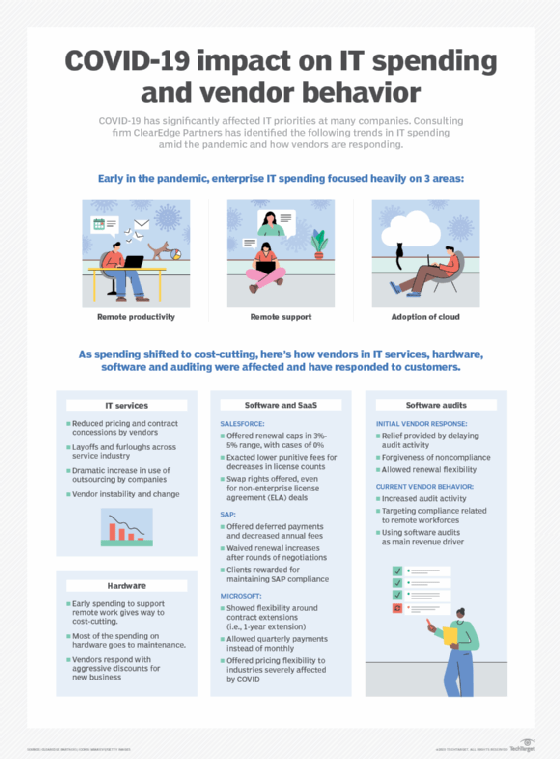
Kzenon - stock.adobe.com
10 ways the pandemic changed digital transformation
The pandemic has brought lasting changes to how companies do business. Here are 10 important ways in which COVID-19 affected digital transformation initiatives.
In the early days of the COVID-19 pandemic, enterprise leaders quickly realized they had to change the way their organizations did business, especially with the advent of employees working remotely. Existing business processes and even formal business models had to be adapted to a new normal where the bulk of operations -- involving employees, partners, vendors and customers -- now happened virtually.
The urgent operational changes provoked by the pandemic came when many companies were actively involved in ambitious digital transformation programs. As advanced digital platforms were being planned and deployed, the pandemic had IT managers scrambling to ensure their resources were geared up to support the sudden increase in remote working, including the following:
- monitoring network resources to ensure the availability of sufficient network bandwidth;
- reviewing existing remote work software licenses -- e.g., for VPN access;
- acquiring additional licenses to accommodate the surge in remote users; and
- reviewing and upgrading network security resources to protect the increased number of remote users from cyber attacks.
10 impacts of COVID-19 on digital transformation
So, how has COVID-19 affected digital transformation roadmaps? Here, we examine 10 significant impacts -- positive and negative -- the pandemic has had on the state of digital transformation.
1. Increased pace of deployment of digital transformation systems
Recognizing that a significant majority of employees would be working remotely, IT managers and technical staff increased the speed of deployment of digital transformation resources, such as advanced e-commerce platforms and supply chain systems, to improve the firm's ability to deploy customer-friendly applications and also tighten up the security and reliability of their supply chains, respectively.
2. Temporary deferral of digital transformation initiatives
Owing to the increased number of remote workers requiring access to company information resources, some IT managers adjusted the deployment schedules for their planned technology rollouts. They did this to ensure the availability of remote work resources, such as VPN access and network bandwidth. Once remote work resources had been deployed, IT managers were able to resume their digital transformation initiatives.

3. Increased use of customer-friendly apps to meet customer expectations
With more of their customers confined to their homes due to pandemic quarantine requirements, business leaders had to ensure their customers had the best possible experience dealing with the firm. That made it even more important to deploy the customer-friendly systems and applications that are the hallmark of successful digital business models.
Digital business with real-time access to customer-focused applications, especially as customers increasingly used mobile devices, rapidly became the new normal. To minimize the likelihood that existing and prospective customers would switch to another website, creating a one-stop shopping experience became a major goal for most organizations deploying e-commerce platforms.
Redefining IT in a Post-Pandemic World
If this pandemic has taught us anything, it is that we need to be and can be more resilient and flexible. Here is a compilation of stories that tackle how to seize opportunities for growth and change, responding to new customer expectations, building collaboration in the workplace, and supporting the office of the future.
Download now
4. Access security for remote workers enhanced
With the dramatic number of remote workers, an organization's potential vulnerability to cyber attacks increased literally overnight. Not only did remote workers need the right access security, but the threat landscape increased for employees using noncompany devices, such as personal laptops and smartphones. Unless the IT department could quickly send new VM images and/or approved security software to remote employees, the vulnerability level increased until those fixes were installed, tested and placed into service. Ideally, remote workers should have company-provided and IT-configured devices, but the added costs and time required to obtain, configure and ship company-approved equipment -- especially for thousands of employees working remotely -- can be prohibitive.
5. Patch management rises to top priority
The pandemic quickly increased the importance of an efficient patch management program, especially where system performance and security might be impacted by the increased number of remote users. Patching ensures that the most current system and application programming is in place, particularly to optimize security. Without strong network security, digital transformation initiatives can be placed at risk via external threat operators. With the pandemic's impact on IT operations, effective patching became even more important, especially when installing patches that improve network perimeter security and update remote access software.
6. Increased use of self-service apps speeds customer data collection
One of the important benefits of digital transformation is the deployment of applications that improve access to self-service resources. This is especially important for providing top-notch customer experience. With self-service, customers can perform more activities on a firm's website, such as shopping, comparing products and prices, and completing transactions. Of greater importance is the access companies gain to the valuable data from customer self-service activities. That data can later be analyzed to identify buying preferences and other metrics. The results can be further transformed into advertising and promotional messages that generate additional customer activity.
7. Shifts in supply chains spur more use of advanced e-commerce platforms
With more people accessing commercial websites due to the pandemic, increased demand for products dramatically impacted supply chains. Organizations realized that, by using advanced e-commerce platforms, they could use data from the apps to analyze and modify supply chains as needed to accommodate shifts in demand.

Continuing education
Digital transformation is not a one-and-done exercise. Technology's rapid evolution and workplace changes ushered in by the pandemic require organizations to continually assess their digital transformation strategies. These books and online courses will help keep you in the know:
8. More collaboration between HR and IT to improve employee experience
With many employees now working remotely, HR faced new challenges, including how people will interact without physical, in-person contact; potential increases in stress and discomfort working remotely; and the need for increased e-learning to ensure employees are still connected to the company and its culture. HR coordination with IT became essential for ensuring that employees had the most positive work experience possible.
9. Increased use of AI in data analysis confers competitive advantage
AI and machine learning play an increasingly important role in digital transformation success. Use of AI technology, for example, can greatly enhance the ability to analyze data from advanced e-commerce platforms and provide a better customer experience. This, in turn, can translate into an improved competitive advantage for the company.
10. Evolution of CIO role
Digital transformation and the impact of the pandemic have accelerated and underscored the decade-long shift in the CIO role from IT operator to business strategist. CIOs have evolved into true partners in the achievement of the company's business goals through their knowledge of advanced technology platforms and their technical teams' experience with new technologies. In the wake of the pandemic, CIOs are also key players in "new normal" work dynamics, such as remote working and the deployment of digital transformation technologies.
Looking for more digital transformation resources?
These articles provide timely advice on the makeup of digital transformation teams, how digital transformation budgets differ from traditional budgets, the importance of culture in digital transformation and more.
Building a digital transformation team: 8 essential roles
The importance of culture in digital transformation







